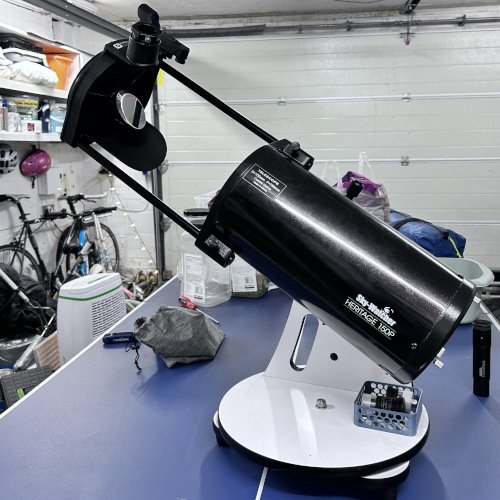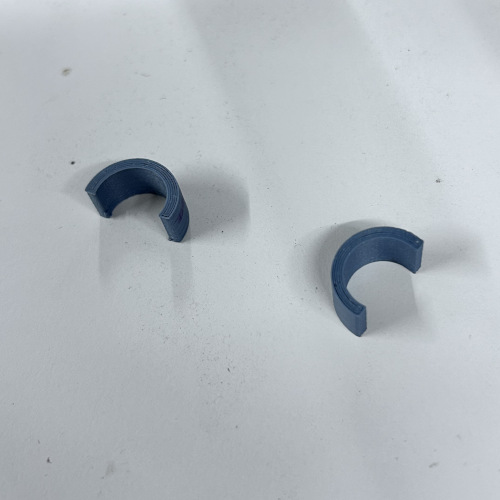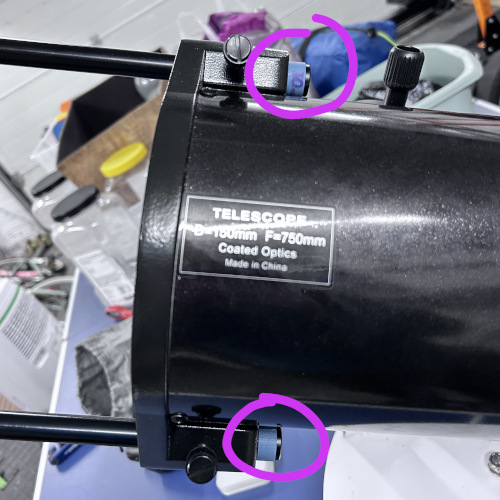Achieving prime-focus on a Sky-Watcher Heritage-150P Telescope
Light-plumbing is hard
Date:
[]
Views: [3448]
Categories:
[astronomy]
Tags:
[skywatcher],
[astrophotography]
When I moved from the city to the suburbs and noticed how dark the skies were, I knew it was time to finally get properly into astronomy. I'd spent the past decade putting things in space that look down at Earth; it was time to flip the script and put things on Earth that looked up into space.
After a lot of back and forth and some helpful advice on the internet, I went for a Sky-Watcher Heritage 150P. It seemed like, at that price point, you could either spend all your money on a mount that does the hard work of pointing or spend all your money on a big mirror which you move manually. The Sky-Watcher Heritage 150P is a Dobsonian telescope, which is very much in the latter camp—it's a big bucket for collecting light and aiming it into your eye.

The long-term goal was to do astrophotography. I'd seen that you can get fantastic results out of a modified webcam and a lot of post-processing. Four years later, I've still not got anything I'm happy with sharing, but the journey through all this light-plumbing has been fantastic—and let's be honest, it's the faffing about with a project that's often more fun than the end result.
For many reasons, a Dobsonian telescope is a terrible choice for astrophotography, and after a lot of experimenting, I found that this scope is particularly bad as its design doesn't allow for a lot of weight to be added at the eyepiece end. However, if you're trying to do this yourself, I thought I'd help by showing how I managed to get prime focus.
Prime focus refers to the point where the telescope's primary mirror gathers and focuses light, creating an image without using additional lenses or eyepieces. This is important for astrophotography, where a camera sensor is placed at this exact spot to capture images directly, rather than viewing through an eyepiece.
With this Heritage telescope, it's almost impossible to reach prime focus as it sits too low to the eyepiece. When you put your webcam or whatever in the eyepiece slot, you can't push it in far enough to achieve focus.
Here's my trick... This is a folding telescope, so you can retract the section with the secondary mirror, which pulls the eyepiece into the place where prime focus lands. To make this easy to find and repeatable, I 3D printed these 10mm C-shaped spacers, which I can clip onto the runners.

Here's the SCAD code I used to generate the washers:
// Parameters
internal_diameter = 15;
external_diameter = 20;
overhang = 0.10;
height = 10;
// Create washer
difference() {
// External cylinder
cylinder(h = height, d = external_diameter, $fn = 100);
// Internal cylinder
translate([0, 0, -1]) // Move slightly below to ensure a proper difference
cylinder(h = height + 2, d = internal_diameter, $fn = 100);
translate([-external_diameter, external_diameter * overhang, -1])
cube([external_diameter * 2, external_diameter, height + 2]);
}And with a little force, they clip nicely onto the scope.

And here's the link to the STL if you'd like to print your own.